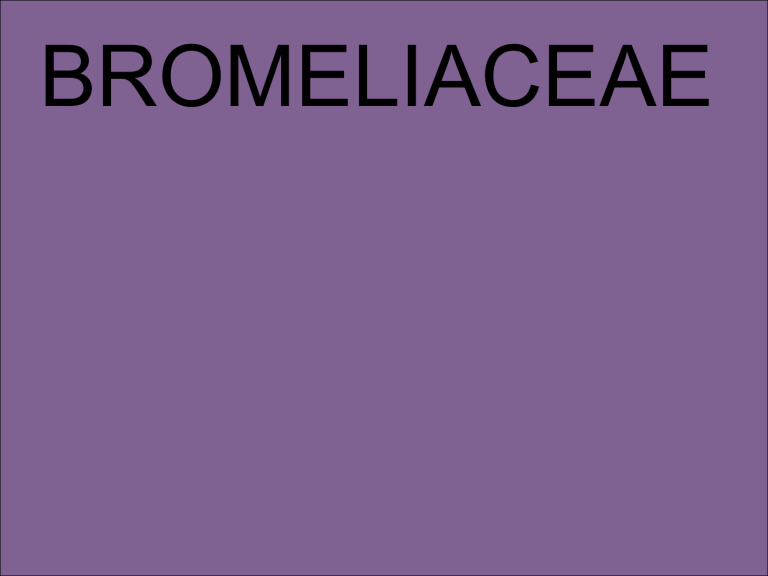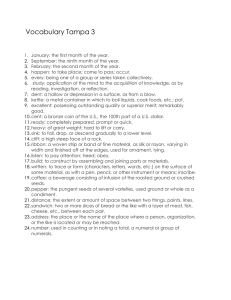BROMELIACEAE

BROMELIACEAE
Epiphyte life form of the bromeliads - Mexico
Epiphyte life form of the bromeliads
Bromelia perianth
monocots
Current
Angiosperm
Phylogeny
Group Tree for Flowering
Plants
Bromeliaceae
Poales
BROM ELI ACEAE (POALES, M ONOCOTS)
NUMBERS: 46 Genera, 2110 species
GEOGRAPHY: tropical (and subtropical) America (one species, Pitcairnia feliciana, in tropical west Africa)
HABITAT: prominent epiphytes, but also terrestial plants
CHARACTERS DIAGNOSTIC OF MONOCOTS: herbaceous, sympodial plants; vascular bundles in stem scattered, closed [no interfascicular cambium developing]; tertiary veins without free endings, leaf base sh eathing; pollen monosulcate, gynoecium three-parted; cotyledon 1; primary root present but unbranched, not persisting.
CHARACTERS DIAGNOSTIC OF FAMILY:
Habit: rosette herbs and he rbs (rarely rosette trees and climbers)
Shoot often reduced (internodes extremely short)
Vessels throughout plant (missing from roots of some epiphytes, wh ich use peltate hairs on surface for water transport)
Leaves spiral (vs. distichous), with broad sheathing base often seving as water trap; terrestrial species usually spiny-edged
Indument includes wa ter-absorbing peltate scales sunk in ep idermal pit.
Crystalline Inclusions: sacs of calcium oxalate raphides abundant in all parts; spherical silica bodies in leaf and stem epidermis
Inflorescence terminal racemes often with bright-colored bracts (continuing shoots sympodial=axillary as in most monocots)
Flowers bisexual, mostly radially symmetrical
Perianth 3 + 3 tepals, more or less differentiated, usually tubular (but not fused)
Stamens 3 + 3 (connate or not, adnate to tepals or not)
Gynoecium 3-carpellate, 3-locular, with septal nectaries; many seeds with helobial endosperm
Pitcairnioideae
(capsules, seeds without hairs)
Floral anatomy of Bromeliaceae including tepal appendages and septal nectaries ---
Sajo et al. 2004 paper to incorporate for 2016
Pitcairnia
Al Gentry photo
Walter Judd photo
Neoregelia flowers sessile in center
Tillandsioideae
(capsules, seeds with hairs)
Tillandsia with inflorescence
Tillandsia - typical habit (Chiapas, Mexico)
Tillandsia usneoides
Tillandsia as decoration,
Chiapas, Mexico
Vriesia sintenisii
Walter Judd photo
Bromelioideae
(berries) Fig 1
(more
Tillandsoideae,
Fig. 2)
The pineapple - terrestrial, leaves with spines, fleshy fruits, inferior ovary, and delicious.
Ananas bracteatus , an ornamental
1 -superior ovary , fruits dry, seeds tailed
2 - superior ovary, fruits dry, seeds comose
3 - inferior ovary, fruits fleshy, seeds without
BROMELIACEAE:
MORPHOLOGY
AND MOLECULES
Bromeliaceae: Neotropical, with the ealiest-diverging species in the
Guayana Highlands
Brocchinia and
Lindmania from the
Guayana Highlands currently stands as most primitive bromeliad
Bromeliaceae: Neotropical except for one species.
Pitcairnia feliciana from
West Africa – the only
Old World bromeliad
Terrestrial to epiphyte transition in the bromelioids: early events
Puya
AndesCosta Rica
Santa Rosa, Costa Rica
Bromelia - habit and fruiting axis
The pineapple - terrestrial, leaves with spines, fleshy fruits, inferior ovary, and delicious.
Ananas bracteatus , an ornamental
Terrestrial to epiphyte transition in the bromelioids: tank and sepal changes
Aechmaea - beautiful, artificial







